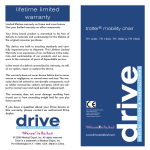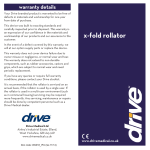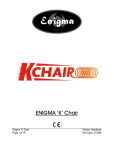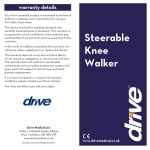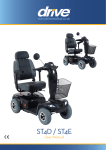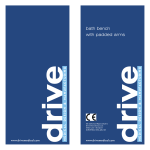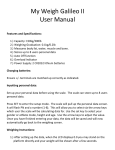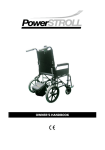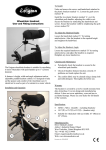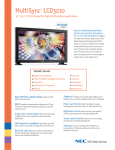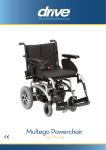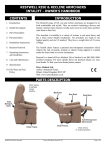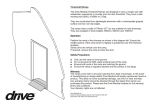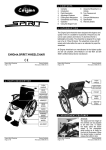Download S1 User Manual - Drive Medical
Transcript
BRAKES - Engage both brakes before getting in or out of the chair, leaning forward in the chair , or while in a lift. The brake should protrude into the tyre by at 3mm (1/8”) when locked. Brakes are engaged by pushing the brake handle completely forward. The brakes are factory set and contact your dealer should they require adjusting. STABILITY - The wheelchair is designed to be safe and stable as long as the user’s centre of gravity is maintained while going about normal activities. Care must be taken while performing activities that shift your centre of gravity in the chair. Never reach so far that require you to shift in the seat or bend over out of the chair. When you have to reach for objects that require you to lean, be certain front castors are pointing in a forward position that extends the wheel base and will stabilize the chair. GRADIENTS - Be sure of your own capabilities, limitations and strength before attempting to go up a ramp. Correct techniques on ramp negotiation should be shown to you by a qualified professional. Assistance is recommended when going up or down inclines greater than 10º. If you must stop on an incline, avoid sudden, abrupt movement when you resume movement. Because of backward angle of the chair, sudden abrupt movement could cause instability. Attempting to use the wheel lock brakes could result in accidental locking, tipping to one side, or cause a sudden stop. Avoid changing direction when going down an incline, as this could result in instability of tipping over. maintenance tips warranty details Proper care and maintenance is important in order to keep your wheelchair in good working order. Be sure that your chair is in proper working order at all times. A qualified dealer or repair centre should be consulted for periodic inspections and repairs: Your Drive branded product is warranted to be free of defects in materials and workmanship for one year from date of purchase. 1. At least once a week, wipe down the frame using a clean soft cloth. If the chair is exposed to moisture, dry the chair immediately. The metal parts of the chair should be polished once a month with an auto wax. 2. Clean the upholstery with a mild soap solution, rinse and wipe dry. Worn or torn upholstery should be replaced promptly as it may not support your body weight. 3. Inspect the wheels at least once a month. Correct any side play by loosening the lock nut on the axle then tighten the axle just enough to remove any play. 4. Solid rubber tyres require limited upkeep, but need to be cleaned periodically with a damp cloth. Solid rubber tyres need to be replaced if they become cracked or severely worn. This device was built to exacting standards and carefully inspected prior to shipment. This warranty is an expression of our confidence in the materials and workmanship of our products and our assurance to the customer. In the event of a defect covered by this warranty, we will at our option supply parts or replace the device. budget steel wheelchair This warranty does not cover device failure due to owner misuse or negligence, or normal wear and tear. The warranty does not extend to nondurable components, such as rubber accessories, castors and grips, which are subject to normal wear and need periodic replacement. If you have any queries or require full warranty conditions, please contact your Drive stockist. troubleshooting Q: What use do you recommend the wheelchair? A: We recommend the wheelchair for indoor and outdoor use. Some outdoor environments such as those with rugged terrains are not suitable for the wheelchair. Q: Do I need to inflate the tyres: A: No. The wheelchair comes with solid tyres so no inflation is needed and there is no chance of punctures. Drive Medical Ltd Ainley’s Industrial Estate, Elland, West Yorkshire, GB Hx5 9JP www.drivemedical.co.uk Part code : Z11999 (Rev A) www.drivemedical.co.uk folding the wheelchair parts description PUSH HANDLE ARM PAD SIDE PANEL Transit Version shown The wheelchair has been designed with an easy fold mechanism. To fold the chair, ensure that the footrests are in the forward position and that the plastic footplates are flipped up. Holding the front and rear edge of the seat sling, pull the seat in an upward motion. The wheelchair will naturally fold up. BRAKE LEG REST REAR WHEEL CASTOR WHEEL introduction Congratulations on your purchase of a Drive wheelchair. Drive wheelchairs are manufactured to meet out own highly rigid specifications and will surpass your expectations. This wheelchair is designed for use indoor and outdoor use. It is suitable for a single occupant with a weight limit of 115kg (18 stone). It can be manually propelled by either the wheelchair user or attendant (self propel) or attendant only (transit). legrest adjustment For optimum comfort it is important to attain the correct leg position. To adjust, slacken the hex head screw at the bottom of the footrest using a spanner. Move the footplate to the required position and then secure the hex head bolt with the spanner. transporting the wheelchair To transport the wheelchair, first fold up the wheelchair as previously described. Then remove the legrests by pushing the chrome lever on the legrests whilst pulling the legrest away from the chair. This operation should unlock the legrest and allow it to be removed by lifting up on the legrest. ! Warning: The wheelchair has not been tested, and must not be used as for use a seat in a motor vehicle using the stepper tube Use the stepper tube to raise the front castors (when mounting a kerb for example). To mount a kerb. Approach the kerb head on. Then the attendant uses the stepper tube to raise the front castors, and lowers the front castors on the raised kerb. Finally the attendant should push the wheelchair forward, lifting it up slightly to mount the kerb if required. To go down a kerb. Line up the front castors with the edge of the kerb. The attendant uses the stepper tube to raise the front castors and tip the user slightly back. Keeping the castors raised, slowly lower the wheelchair down the kerb. ! Warning: Do not raise the front castors by pushing down on the push handles as this could result in damage to the wheelchair. operation and propulsion The wheelchair can be propelled by the wheelchair user using the rear wheel handrims or by an attendant using the push handles. To apply the parking brakes, push the plastic brake handle towards the front of the wheelchair. Push the handle back to release the brakes. The brakes should be used as parking brakes when the wheelchair is stationary. Apply reverse pressure to handrims or push handles to slow the wheelchair during operation. Use slow speeds on gradients. Do not use on gradients larger than 10º The wheelchair is only suitable for single occupancy. The wheelchair user should keep their feet on the footplates when moving. Do not stand on the footplates. Do not use escalators. Do not reverse down a gradient Maintain proper balance at all times. Users should not move their centre of gravity out of the seating area. Do not reach for items further than your arm will extend. Be aware of hazards in your environment, such as narrow doorways, steps, household appliances, children's toys, etc. We recommend you consult your healthcare professional for advice about transferring to and from the wheelchair. The parking brakes should always be applied when transferring. The wheelchair brakes are parking brakes and are not suitable for slowing the wheelchair down. specification Wheelchair (cm/in): (Self Propel) 61W x 106L x 90H (cm) 24”W x 42”L x 35”H (in) Seat (cm/in): 45W x 40D x 50H (cm) 18”W x 16”D x 20”H (in) Width Closed: 26cm / 10” Wheelchair Weight: Weight Capacity: 18kg (39lb) 18 stone (250lb) Wheelchair (cm/in): (Transit) 60W x 88L x 91H (cm) 24”W x 35”L x 36”H (in) Seat (cm/in): 45W x 40D x 49H (cm) 18”W x 16”D x 19”H (in) Width Closed: 26cm / 10” Wheelchair Weight: Weight Capacity: 14.6kg (29lb) 18 stone (250lb)





